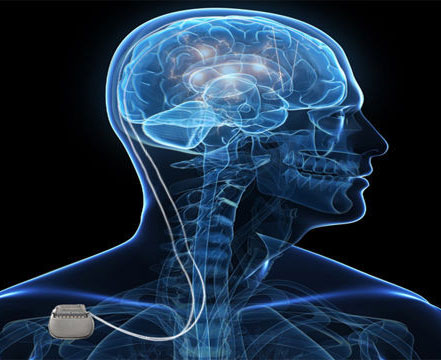Deep Brain Stimulation
Deep Brain Stimulation
Our ability to move and control our muscles is the result of a complex communication system between our brains and our bodies. For example, if we want to smile or lift our arm up, our brain sends out a signal to the muscles required to achieve that movement, essentially telling them what to do. The result is a smile or a raised arm. The reverse is also true. If we want to sit still, our brain also sends signals to our muscles telling them not to move.
But our capacity to control our bodies can be compromised. Certain neurological disorders, such as Parkinson’s disease, can disrupt these signals and reduce our brain’s ability to communicate effectively. The result is a movement disorder that manifests as symptoms such as an uncontrollable twisting, contracting or contorting of the muscles. Deep Brain Stimulation (DBS) is a surgical procedure that can prevent the symptoms associated with movement disorders, such as Parkinson’s disease, from manifesting.
Deep Brain Stimulation (DBS) involves inserting electrodes into the parts of the brain responsible for controlling movement. When in place, the implanted electrodes release small electrical pulses into the brain, via a fine wire connected to a surgically implanted, battery-operated medical device called a neurostimulator – neurostimulators are quite small; about the size of a stopwatch. These electrical pulses stimulate the targeted areas of the brain and prevent the abnormal electrical signals that cause movement disorders symptoms to manifest.
It is a procedure typically used to help treat movement disorders such as essential tremors, dystonia, Tourette’s syndrome, epilepsy, chronic pain, and obsessive-compulsive disorder which have not responded to traditional medications. Recent studies also show that DBS may be useful in treating the symptoms of other conditions associated with neurological dysfunction, such as dementia, stroke recovery, addiction and deep depression.
Although Deep Brain Simulation is safe, all types of surgeries minor or otherwise come with risks and the potential for side effects. Because DBS involves cutting small holes into the skull to allow the insertion of electrodes, surgical complications can sometimes lead to bleeding in the brain, infection, stroke, nausea, seizures and, in some cases, heart problems. Side effects may also include symptoms such as headaches, confusion, or seizures.
Our team of trusted neurological experts at MDPDS have conducted hundreds of successful Deep Brian Stimulation procedures and helped hundreds of individuals overcome the debilitating and often life-changing symptoms associated with movement disorders like Parkinson’s disease. We know how difficult it is to feel like you are not in control of your body, but we also know what treatments are to help you take back control.
We work tirelessly behind the scenes with you to understand your unique circumstances and constantly assess what treatment options are available or soon becoming available in order to provide you with the best available care for you. We are always available and open to discussing your options and can help you to decide whether or not DBS is, in fact, the right approach for your circumstance.

Make an Appointment
There is no such thing as a one-size-fits all treatment. As such, we work closely with you to understand your unique circumstances and design care programs that fit your individual needs.
Use Telehealth
No matter where you are or what your movement disability may be, telehealth services ensure that we are always connected and able to assist you, 24/7.
